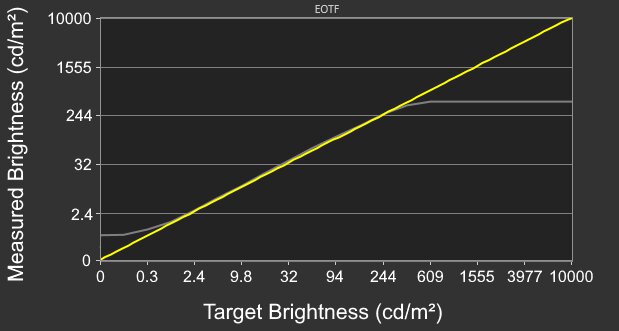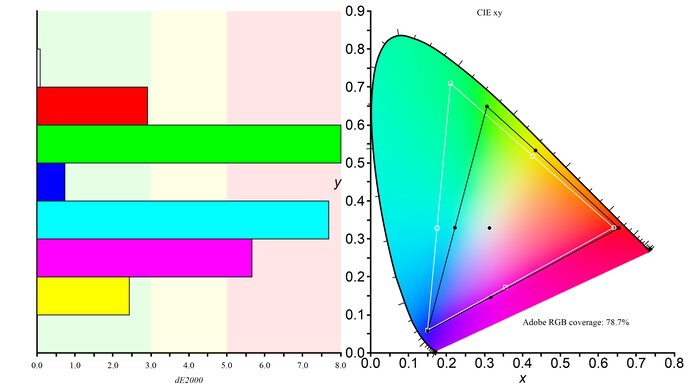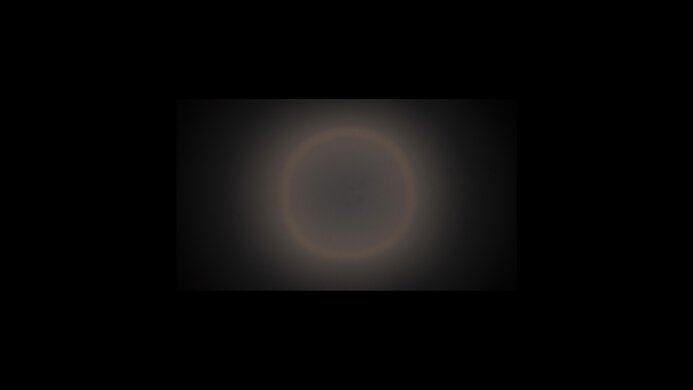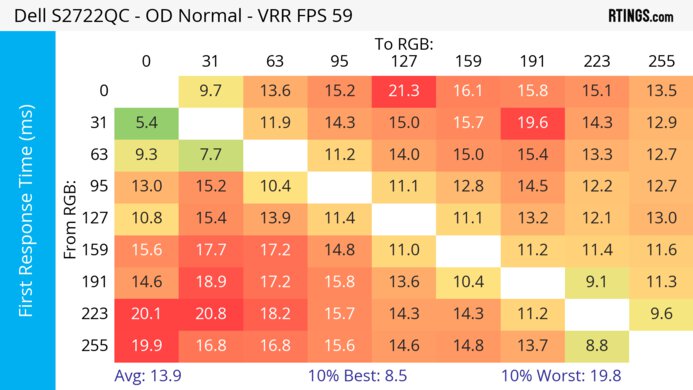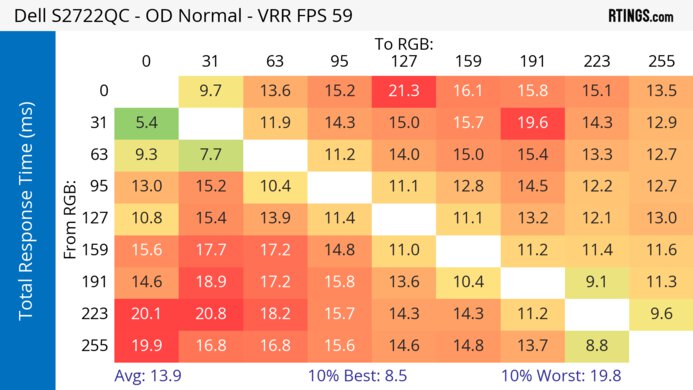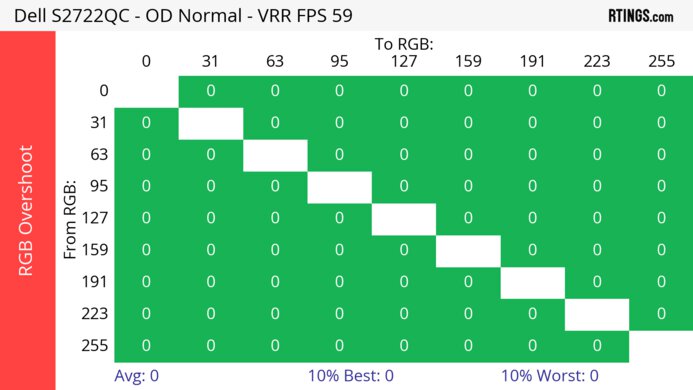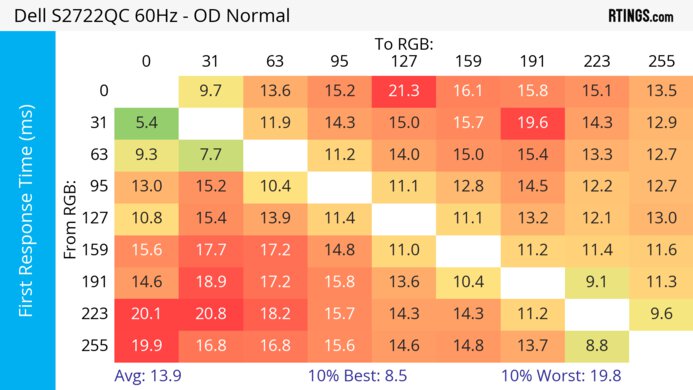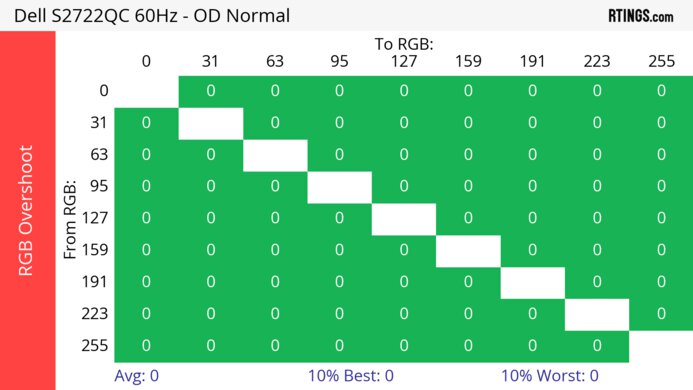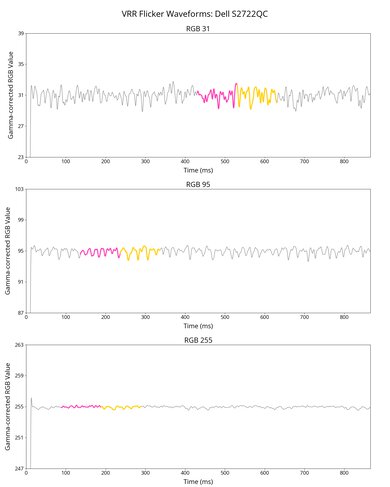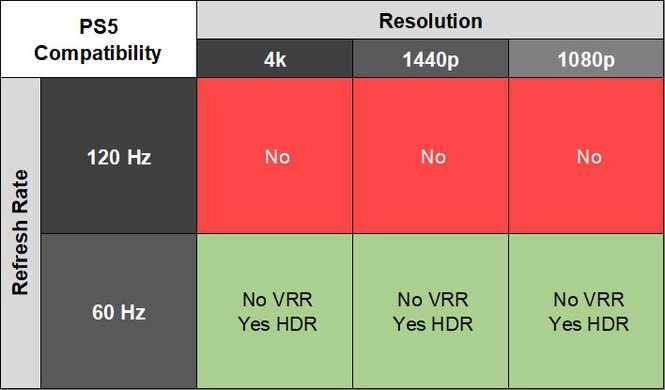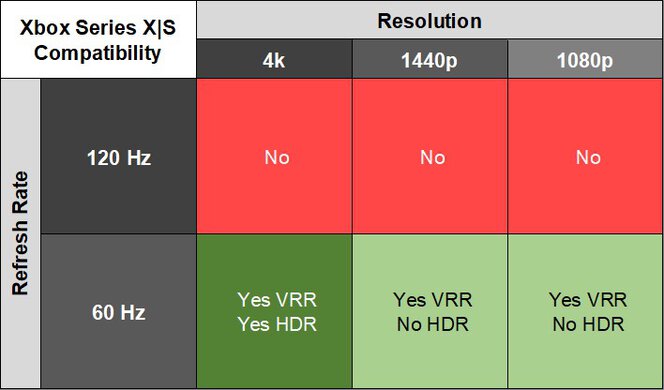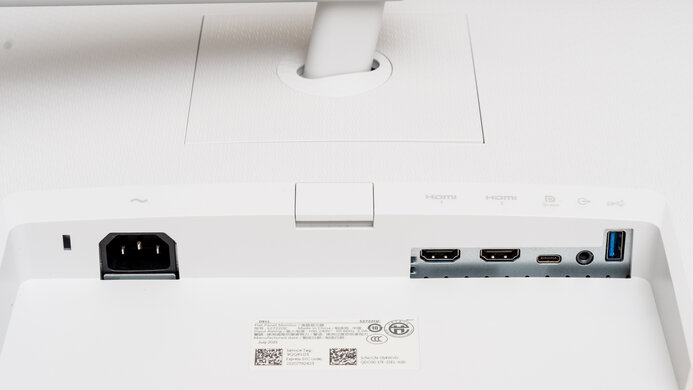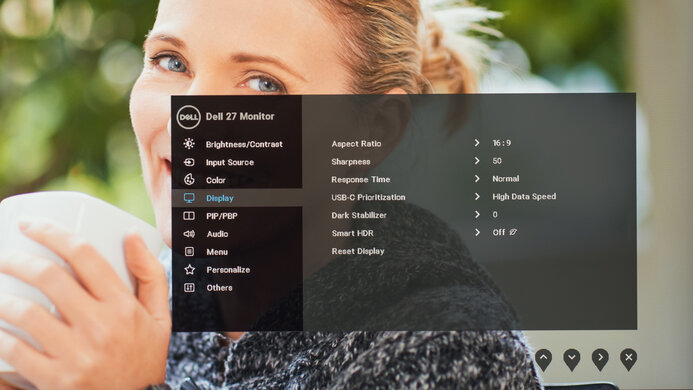The Dell S2722QC is a 27-inch, 4k monitor aimed at productivity. It's an updated version of the Dell S2721QS with a different selection of inputs. This monitor has a USB-C input that supports DisplayPort Alt Mode with power delivery, allowing you to connect your laptop to display an image and charge it with the same cable. It has additional productivity features, like Picture-in-Picture and Picture-by-Picture modes, so you can display images from two different sources at the same time. It also has FreeSync VRR support to reduce screen tearing, though it's otherwise limited in gaming features.
Our Verdict
The Dell S2722QC is mediocre for PC gaming. Although it has VRR support, it has few gaming features, as it's limited to a 60Hz refresh rate and lacks HDMI 2.1 bandwidth. It has low input lag for a responsive feel, but motion looks blurry due to its slow response time. Unfortunately, it has limited picture quality because it has a low contrast ratio that makes blacks look gray, and it lacks a local dimming feature to further improve it.
- Low input lag.
- VRR support.
- Limited to 60Hz refresh rate and HDMI 2.0 bandwidth.
- Mediocre contrast ratio.
- Blurry motion due to slow response time.
The Dell S2722QC is bad for console gaming. It can't take full advantage of the Xbox Series X|S or PS5 because it's limited to a 60Hz refresh rate and lacks HDMI 2.1 bandwidth, but it has a high 4k resolution to deliver detailed images. However, it has limited picture quality due to its low contrast, so it fails to deliver realistic images. Although it has low input lag for a responsive feel, its slow response time makes motion look blurry.
- Low input lag.
- Sharp text and image clarity.
- Limited to 60Hz refresh rate and HDMI 2.0 bandwidth.
- Mediocre contrast ratio.
- Blurry motion due to slow response time.
The Dell S2722QC is excellent for office use. The 4k resolution produces incredible text clarity, and the 27-inch screen is a good size for multitasking. It has fantastic ergonomics that make it easy to adjust it to your preferred position, and the wide viewing angles are ideal for sharing your screen with others, as the image remains consistent from the sides. It also has a few extra office-friendly features, like a USB-C input with power delivery, so you can connect your laptop and charge it at the same time with a single cable.
- Fantastic ergonomics.
- USB-C input with DisplayPort Alt Mode.
- Bright enough to fight glare.
- Sharp text and image clarity.
The Dell S2722QC is good for content creation. It delivers sharp images and text thanks to its 4k resolution and high pixel density. Its accuracy before calibration is decent, though it needs a full calibration for the most accurate image. However, it has limited Adobe RGB coverage, so it doesn't display some colors during photo editing, and it also has a low contrast ratio that makes blacks look gray. Luckily, it has wide viewing angles and fantastic ergonomics, so the image remains consistent from the sides, and you can adjust it to your preferred position.
- Wide viewing angles.
- Fantastic ergonomics.
- USB-C input with DisplayPort Alt Mode.
- Bright enough to fight glare.
- Sharp text and image clarity.
- Lacks sRGB mode; needs full calibration.
- Mediocre contrast ratio.
- No local dimming.
The Dell S2722QC has decent brightness. It gets bright enough to fight glare, but highlights don't pop in HDR.
- Bright enough to fight glare.
- Highlights don't pop in HDR.
The Dell S2722QC has a poor response time, so motion looks blurry and has smearing.
- Blurry motion due to slow response time.
The Dell S2722QC has poor HDR picture quality. It has a low contrast ratio that makes blacks look gray, and it lacks a local dimming feature to further improve it. It also fails to make colors look vivid in HDR.
- Mediocre contrast ratio.
- No local dimming.
The Dell S2722QC has decent SDR picture quality. While it displays a wide range of colors, it has a low contrast ratio that makes blacks look gray in dark rooms.
- Displays wide range of colors.
- Mediocre contrast ratio.
The Dell S2722QC has very good color accuracy. Although it lacks a dedicated sRGB mode, it has decent accuracy before calibration. That said, it still needs a full calibration for the best accuracy.
- Good gray uniformity.
- Lacks sRGB mode; needs full calibration.
Performance Usages
Changelog
- Updated Nov 10, 2025: We've converted this review to Test Bench 2.1.1. We removed the Vertical Viewing Angle test.
-
Updated Sep 12, 2025:
Added in the Popular Monitor Comparisons section that the Dell S2725QC is an updated version with newer features.
-
Updated Jul 23, 2025:
We updated text throughout to match the new and updated tests with Test Bench 2.1, including in the Verdict section.
- Updated Jul 21, 2025: We've converted this review to Test Bench 2.1. This includes new tests for Direct Reflections, Ambient Black Level Raise, and Total Reflected Light. You can see all the changes in the changelog.
Check Price
Differences Between Sizes And Variants
We tested the 27-inch Dell S2722QC, which is the only size available for this monitor. It's an updated version of the Dell S2721QS with a few differences, and you can see some differences between some monitors in the Dell S Series lineup below. The results in this review are only valid for the S2722QC.
| Model | Panel | Size | Resolution | Stand Adjustments | Connectivity |
|---|---|---|---|---|---|
| S2721QS | IPS | 27" | 4k | Tilt, Swivel, Height, Portrait | HDMI, DisplayPort |
| S2722QC | IPS | 27" | 4k | Tilt, Swivel, Height, Portrait | HDMI, USB-C, USB-A |
| S3221QS | VA | 32" | 4k | Tilt, Height | HDMI, DisplayPort, USB-A |
Our Dell S2722QC unit was manufactured in July 2021; you can see the label here.
Popular Monitor Comparisons
The Dell S2722QC is a great mid-range 4k office monitor. It has many productivity features like its USB hub that includes a USB-C port, and the 4k resolution ensures crisp text. If you need something for the office and want to take advantage of the USB-C input, it's worth the upgrade over the Dell S2721QS. However, if you're looking for a monitor that can display a wider range of colors in HDR and has better color accuracy before calibration, in addition to a larger USB hub and a KVM switch, consider the Dell U2723QE instead. You can also consider the newer Dell S2725QC if you want an updated model with a higher 120Hz refresh rate for a smoother feel.
See our recommendations for the best 4k monitors, the best work monitors, and the best monitors under $500.
The Dell S2725QC is an updated version of the Dell S2722QC. The S2725QC comes with a higher 120Hz refresh rate for a smoother feel and HDMI 2.1 bandwidth for better compatibility with modern graphics cards and gaming consoles. The picture quality is similar between them, but the S2725QC also comes with an sRGB mode for more accurate out-of-the-box colors than the S2722QC. The S2722QC still has some advantages, like the fact that it has an audio jack, and it feels better built than the S2725QC.
The Dell S2722QC is an updated version of the Dell S2721QS with many of the same features, but there are a few differences. They're built the same and have similar picture quality with an IPS panel with wide viewing angles and a 4k resolution. However, the main differences are with the inputs: while the S2722QC has a USB-C input and two USB 3.0 inputs, the S2721QS has a DisplayPort input, which the S2722QC doesn't have.
The Dell UltraSharp U2720Q and the Dell S2722QC are similar 4k monitors. The picture quality is about the same between both, but the S2722QC is better for well-lit rooms because it gets brighter. On the other hand, the U2720Q has a better selection of inputs because it has an extra USB-C and USB 3.0 input compared to the S2722QC, and it also has a DisplayPort input. While both monitors have ergonomic stands, the one on the U2720Q offers a wider swivel range and higher height adjustment.
The Dell S2722QC and the Dell U2723QE are both good overall 4k monitors. The picture quality is similar between both, except the U2723QE has much better out-of-the-box accuracy and higher contrast and displays a wider range of colors in HDR. The U2723QE also has more inputs, like a DisplayPort output that you can use for daisy chaining and multiple USB-C ports. However, the S2722QC is slightly more versatile for gaming because it supports VRR.

We buy and test more than 30 monitors each year, with units that we buy completely on our own, without any cherry-picked units or samples. We put a lot into each unbiased, straight-to-the-point review, and there's a whole process from purchasing to publishing, involving multiple teams and people. We do more than just use the monitor for a week; we use specialized and custom tools to measure various aspects with objective data-based results. We also consider multiple factors before making any recommendations, including the monitor's cost, its performance against the competition, and whether or not it's easy to find.
Test Results

The ergonomics are fantastic, making it easy to adjust the monitor to your preferred position. The back of the monitor features textured white plastic. You can easily remove the stand from the screen if you choose to VESA mount it. The hole in the stand also offers basic cable management.
This monitor doesn't have a local dimming feature. We still film these videos on the monitor so you can compare the backlight performance with a monitor that has local dimming.
The SDR brightness is great. It gets bright enough to fight glare in a brighter room and maintains the brightness well across different content. These measurements are from after calibration in the 'Custom Color' Picture Mode with the Brightness at its max.
The HDR brightness is okay. Highlights don't pop, but it follows the PQ EOTF curve fairly well, with a fairly sharp roll-off at peak brightness, so it lets highlights get the brightest they can before any tone mapping.
These measurements are in the 'Desktop' Smart HDR mode, which locks the brightness at its max. There's very little difference in brightness with the other modes, but the 'Movie HDR' setting doesn't track the EOTF curve as well since almost all scenes are overbrightened.
The accuracy before calibration is decent. It doesn't have a dedicated sRGB mode, so colors are oversaturated, but other than that, it looks fine. The color temperature is extremely close to the 6500K target, and the white balance is only a bit off. However, gamma follows a strange pattern, as very dark and very bright scenes are too dark, while other scenes are overbrightened.
The accuracy after calibration is remarkable. Calibration fixes most inaccuracies and significantly improves every measurement.
The SDR color gamut is superb. It has perfect coverage of the commonly used sRGB color space, but it has more limited coverage of the Adobe RGB color space, which isn't ideal for professional publishing.
The HDR color gamut is alright. It has decent coverage of the DCI-P3 color space used by most current HDR content, but its Rec. 2020 color space coverage is more limited. However, it struggles with tone mapping, so most colors are inaccurate.
The horizontal viewing angle is great. It works well if you need to share your screen with someone sitting next to you, as they'll see a consistent image from the sides.
The direct reflection handling is okay. The matte coating spreads light out, but there are still some mirror-like reflections.
The black levels rise in a bright room, and combined with its low native contrast ratio, this means that blacks look gray in any room.
Due to bandwidth limitations over HDMI, you can only reach a max of 30Hz with a 4k resolution, 10-bit color depth, and chroma 4:4:4. You would need to use chroma 4:2:2 or 4:2:0 if you want a higher refresh rate with 10-bit color depth, but that worsens text clarity. However, you can get a 4k @ 60Hz, 10-bit signal with chroma 4:4:4 over USB-C if you set USB-C Prioritization to 'High Resolution.'
| NVIDIA | VRR Min | VRR Max |
| DisplayPort | 42Hz | 60Hz |
| HDMI | N/A | N/A |
| AMD | VRR Min | VRR Max |
| DisplayPort | 42Hz | 60Hz |
| HDMI | 42Hz | 60Hz |
| Refresh Rate | CAD Heatmap | RT Chart | Pursuit Photo |
| 59 | Heatmap | Chart | Photo |
The motion handling with VRR enabled is poor. There's clear blur and smearing with fast-moving objects. The 'Extreme' and 'Fast' settings have more inverse ghosting than 'Normal.' 'Extreme' has such a high CAD that it passes the limits of our chart, and you can see an alternative chart here.
The refresh rate compliance is bad. Its response time isn't fast enough to make full transitions before the monitor draws the next frame.
| Overdrive Mode | CAD Heatmap | RT Chart | Pursuit Photo |
| Normal | Heatmap | Chart | Photo |
| Fast | Heatmap | Chart | Photo |
| Extreme | Heatmap | Chart | Photo |
The CAD at the max refresh rate of 60Hz is disappointing. Motion is blurry with the 'Normal' overdrive setting, and using the 'Fast' and 'Extreme' settings results in too much inverse ghosting.
This monitor doesn't support a 120Hz signal.
This monitor doesn't support a 120Hz signal.
This monitor has no optional backlight strobing feature to reduce persistence blur.
This Dell S2722QC Monitor has low input lag, so you won't notice any delay and will get a responsive feel.
This monitor has limited compatibility with the Xbox Series X|S, as it lacks HDMI 2.1 bandwidth to take full advantage of it. Keep in mind that the Xbox doesn't support HDR with 1080p or 1440p signals, so this isn't a limitation of the monitor.
This monitor is limited to HDMI 2.0 bandwidth, and if you want an HDMI 2.1 monitor, check out the Dell G3223Q.
The USB-C input supports DisplayPort Alt Mode and power delivery, allowing you to charge compatible devices and display an image from them at the same time. You can also use the USB 3.0 inputs to charge devices. If you want something with more USB inputs, look into the Dell U2723QE.
This monitor works well with macOS. Scaling defaults to 1080p, but you can change it to 4k. The monitor supports both VRR and HDR properly on macOS. When using a MacBook, windows return to their original position when waking the laptop up from sleep.
There are widespread reports of flicker when using this monitor with M1 Macs. While we haven't been able to reproduce this issue with our unit, some users report that increasing the Contrast to '90' or higher fixes this issue.
The monitor has a few extra features, including:
- Picture-in-Picture and Picture-by-Picture: Displays the images from two inputs on the screen at the same time.
- USB-C Prioritization: Toggle to enable either 4k @ 60Hz 10-bit color or high data speeds over USB-C.
- Dark Stabilizer: Brightens darker scenes to assist in gaming.











